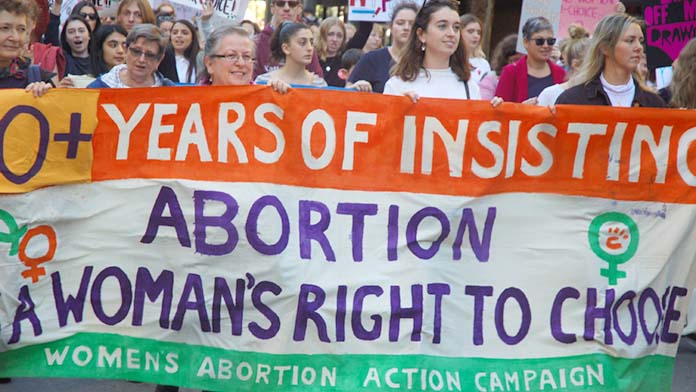In 2022, when the US Supreme Court overturned the 1973 Roe V Wade ruling that gave the right to abortion constitutional protection, thousands came out in solidarity to protest in Australia.
Long-time campaigner for abortion rights Barbara Baird hoped that those demonstrators were also showing concern for the need to change the conditions under which abortion is available here.
Baird has written extensively on abortion law and politics. In this book, Abortion Care is Health Care, she examines the state of abortion provision in Australia in a history of reproductive health since 1990.
The book incorporates extensive interviews with health professionals, activists, journalists and patients who are presented as “champions” for their dedication to what can be a politically dangerous field; most must remain anonymous.
Significantly, she argues: “The battle for affordable, accessible, and appropriate abortion care in Australia is far from over.”
The concept of battle creates an impression that the issue is evenly polarised and extremely controversial. Yet the majority of people support abortion rights.
Even in the US about 70 per cent of the voting population (and 74 per cent among young people) support abortion rights, according to recent ballots and opinion polls. In Australia the figure is around 75 per cent.
Abortion is a safe simple procedure when performed by trained practitioners. Yet, from the 1800s in Australia abortion was deemed a crime and then the laws were liberalised in the 1970s and 80s.
Decriminalisation, beginning in the ACT in 2002 and then finishing in WA in 2023, improved the situation by removing abortion as an offence under the criminal law. Pregnant people can request an abortion without doctors’ approvals in the first trimester.
Many people think the legal hurdles are a thing of the past. However, even in Australia abortion access is far from ideal.
Unfortunately, the laws also create legal certainty for those who would restrict the provision of abortion. Anti-abortion politicians took the opportunity in parliamentary debates to shape the legislation. A range of unnecessary restrictions, like lengthy consultation periods and special conditions for abortion provision beyond the first trimester of gestation were codified in laws.
Despite the gains, abortion remains the only health procedure affected by religion, stigma and shame for doctors, midwives, nurses and patients.
Baird helps us understand this conundrum but doesn’t have an adequate explanation for what causes this situation and how to win the demands we agree on – free, safe abortion on demand.
Baird writes from the perspective that “the person with an unwanted pregnancy should be at the centre of our thinking about abortion”. This analysis reveals that the way the laws are applied to the inadequate underfunded reproductive healthcare industry, creates confusion and precarity for pregnant people.
A special form of healthcare
Statistics are incomplete in Australia, but about one-third to one-quarter of women will have to seek an abortion to protect their health and well-being. Yet many pregnant people will find access to abortion impossible because of cost, lack of facilities and doctors.
Baird correctly argues that the privatisation of health services, which accelerated with the rise of neoliberalism, is a driver for undermining Australia’s crisis-prone underfunded healthcare system, including all reproductive health services.
She situates abortion services as part of the broader system, an industry controlled by federal and state government regulation which fails to provide an adequate service.
While government hospitals perform abortions in some Australian states (especially South Australia and Northern Territory) most are provided in private clinics.
Many pregnant people find themselves in a federally funded Catholic Church-run private hospital. Because these institutions adhere to anti-abortion principles that do not allow most reproductive health services, especially abortion, they effectively ban all pregnancy terminations despite the legal environment.
Greens senator Larissa Waters stated: “This… would not be accepted if it were any other area of health care… It is outrageous that private hospitals receiving public funding denied healthcare to pregnant people in need.”
Doctors are not compelled to perform abortions, although they remain the only legally sanctioned abortion practitioners. All healthcare workers can claim a conscientious objection and refuse to perform a range of reproductive health services, although legally they are expected to refer patients to non-objecting professionals.
Abortion doctors and providers are limited to finding cracks in the public health system and establishing their own private clinics usually without state support. Without adequate public hospital resources, quality training remains difficult to obtain.
The private sector, dominated by MSI Australia (British company Marie Stopes) partially fills a huge gap, but at a cost to patients.
However, the priority for private businesses is profit rather than quality patient care. Even not-for-profit clinics, like MSI Australia, are geared to make a surplus to invest in new businesses. Medicare allows a rebate which partially allays some costs of patients.
While most discussion of discrimination regarding abortion service availability refers to a “postcode lottery”, the needs of Indigenous, migrant, poor, intersex, trans, disabled and younger people are often disregarded.
Baird explains the myriad ways people are denied what should be a human right, saying: “Based on the economics and geography of access alone, the system creates reproductive injustice for about one-third of all people who have an abortion, and for all those who have no choice but to continue an unwanted pregnancy.
“These are often people who are already severely marginalised by poverty, geography, isolation, youth, lack of internet literacy or connection, lack of Medicare entitlement, violent and coercive relationships, racism, ableism, homophobia and transphobia, and by abortion’s own internal ‘other’: presenting ‘late’.”
What is labelled “late” abortion especially after 20 weeks’ gestation also features in the discussion about which bodies are deserving and which not. Baird says: “The fact that only a small number of people need late abortions is no reason to allow governments, hospitals and the medical profession to deny them reproductive justice.”
Abortion, oppression and the state
The book raises important questions about the role of the state in imposing unnecessary laws and reinforcing gender-based and racist stereotypes, which has contributed historically to the denial of adequate reproductive health services.
In a colonial settler state like Australia, abortion laws were initially ideologically directed overwhelmingly to white women in the interests of maintaining the white population. Indigenous women and people with disability suffered forced sterilisation and child removal.
Today oppressed groups such as Indigenous people face poorer access to abortion and other health services.
In the early 2000s the Howard government acted to prevent the import and availability of the abortion pill RU486, which had been available in France since the1980s.
The state continues to frame the circumstances for access to abortion with both law and industry regulation.
Baird argues: “This book understands the issue of access to abortion care through a framework that feminists in the USA have called Reproductive Justice. This is a set of principles that sees human rights for all, regardless of age, ability, class, race, sexuality or gender, as inclusive of the right to continue or not with pregnancy, to be supported in providing a safe and nourishing environment in which to raise children, and to have access to adequate health care.
“The book focuses on abortion in the context of the full range of reproductive issues. It aims to contribute to the achievement of reproductive justice.”
While this analysis provides an important description of the situation we face today, it does not explain the cause of injustice and how it benefits capitalism.
Women’s bodily autonomy is restricted in the interests of gendered norms to facilitate unpaid labour bringing up the next generation of workers, producing gendered oppression.
Other forms of oppression—racism, disability, homophobia, transphobia—generate other forms of discrimination as part of ruling class strategies to divide the working class and anti-capitalist social movements.
The roots of women’s oppression lie in the nuclear family, which as a capitalist institution is part of the social structure that shapes women as carers of children.
Abortion rights are restricted because they limit the state’s control over fertility and the role of the nuclear family to reproduce labour power cheaply.
Yet we have won reforms and some reproductive rights.
Baird does not draw out the nature of the state and the system as capitalist.
Yet, this situation reveals an important contradiction for capitalism—the capitalist economy also requires women’s labour. Thanks to the struggle by trade unionists, the Australian state recognises women’s right to work and equality.
The government and the bosses want it both ways—women who work are expected to also prioritise caring responsibilities. During the early days of the COVID pandemic governments accepted that women increased their child caring role in the home as schools closed.
Post Roe V Wade in the US major capitalists are playing a double-edged game—Amazon offered financial support for employees who needed to travel to access legal abortion but also donated to anti-abortion and the right-wing campaigns for total bans on abortion.
The contradictions in social policy and practice can help activists recognise strategies for change. The ACT government announced last year that abortion would be provided free of charge during the first 16 weeks, showing that such reforms are possible everywhere. Medical abortion, which involves using two abortion pills during the first nine weeks, is becoming more widespread, especially where there are telehealth facilities.
This contradictory situation reflects the problem for capitalism – who will pay for social reproduction? The working class families or the capitalists?
The capitalist class is unwilling to pay and relies on oppression to create and reproduce labour to produce society’s wealth in exploitative relations.
Abortion restrictions are part of the system of exploitation and oppression. They are a reminder that, for women, caring for current and future generations of labour is their key role.
For most of human history gender oppression and racism did not exist.
Abortion rights were won in Anglophone countries in the 1970s, with the rise of women’s liberation movement campaigns which were part of widespread mass struggle. The working class played a much bigger role and industrial action often underpinned political struggles. Unions were won to support the campaigns for equal pay and abortion rights.
Today the union movement is dominated by women workers who have raised a series of demands for better working conditions, like paid parental leave and paid menstruation leave.
The NSW government employees enjoy paid leave in the event of miscarriage and for fertility treatment.
It’s time to achieve leave for all reproductive health, including abortion, when needed.
Abortion has always been more than a women’s issue, it affects all genders, men and women, gay and straight, people of colour and white, and we are strongest when we fight unitedly in our workplaces.
Fight for free quality reproductive healthcare
In Australia abortion rights are enshrined in new decriminalised legal structures, although they remain inadequate. Significantly, the under-resourced reproductive healthcare system means large numbers of pregnant people cannot realise these limited rights.
Despite the state’s oppressive role, Baird correctly calls for free publicly-funded universal quality healthcare, including reproductive healthcare, Australia-wide.
Our immediate target should be the federal Labor government. Before the 2019 federal election the Labor Party promised that, if elected, the Commonwealth-state hospital funding agreements would “expect termination services to be provided consistently”.
That pledge was dumped before the 2022 election and the results of a new Senate enquiry do not go far enough. Greens senator Larissa Waters called on Prime Minister Anthony Albanese to “revert to Labor’s 2019 policy of requiring private hospitals [including the Catholic Church-run hospitals] to provide abortion care as a condition of receiving public funding”.
These demands are realisable in a wealthy country like Australia. For a fraction of the billions spent on fossil fuel industry subsidies and nuclear submarines, the government could fully fund reproductive healthcare.
Capitalism allows space for anti-abortion governments, bigots and the far right which are a threat in many countries, and also for limited abortion rights like most recently legislated in France where President Macron has said he “wants to make women’s freedom to choose an abortion ‘irreversible’.”
Therefore, the struggle for abortion rights will continue.
So that everyone has a real choice whether to give birth or not, governments should guarantee full access to free, safe, reliable and culturally appropriate contraception and abortion on demand, as well as services for safe childbirth and the raising of children.
Baird never forgets the need for activism and argues that abortion rights are won through political struggle. Her work is essential in the toolbox for activists.
Working class struggle was necessary to push back the anti-abortion right recently in Ireland and Argentina, where abortions are now provided free and safely as part of the public health systems.
Such a struggle is possible because in most countries a large majority supports abortion rights. The working class can be mobilised to win change as shown in our own history in Australia.
By Judy McVey
Barbara Baird, Abortion Care is Health Care, Melbourne University Press (2023).






